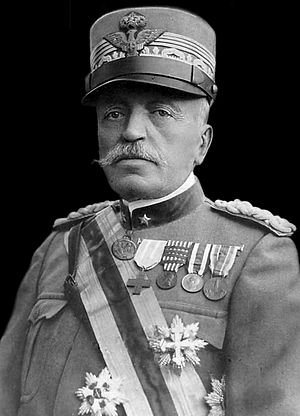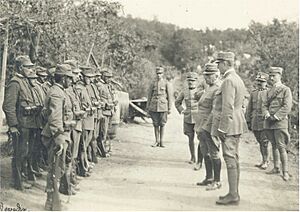Luigi Cadorna facts for kids
Quick facts for kids
Marshal of Italy
Luigi Cadorna
OSML OMS OCI
|
|
|---|---|
 |
|
| Chief of Staff of the Italian Army | |
| In office 27 July 1914 – 9 November 1917 |
|
| Preceded by | Alberto Pollio |
| Succeeded by | Armando Diaz |
| Personal details | |
| Born | 4 September 1850 Verbania, Kingdom of Sardinia |
| Died | 21 December 1928 (aged 78) Bordighera, Kingdom of Italy |
| Nationality | |
| Profession | Military officer |
| Awards | Order of the Bath, Grand Cross |
| Military service | |
| Allegiance | |
| Branch/service | |
| Years of service | 1865–1917 |
| Rank | Marshal of Italy General |
| Battles/wars | Capture of Rome World War I
|
Luigi Cadorna (born September 4, 1850 – died December 21, 1928) was an Italian general. He became a Marshal of Italy and a Count. He is best known for being the Chief of Staff of the Italian Army during World War I, from 1914 to 1917. During this time, he was known for his very strict leadership and his focus on attacking. He was removed from his position after a major defeat called the Battle of Caporetto in late 1917.
Contents
Early Military Career
Luigi Cadorna was born in Verbania, Piedmont, in 1850. His father, Raffaele Cadorna, was also a general. In 1860, Luigi started studying at the "Teuliè" Military School in Milan. When he was fifteen, he joined the Turin Military Academy.
After finishing his studies, he became a second lieutenant in the artillery in 1868. In 1870, Cadorna helped his father's forces take control of Rome. Later, he worked on the staff of General Pianell. He then became the Chief of Staff for the Verona Divisional Command.
As a colonel leading the 10th Regiment of Bersaglieri from 1892, Cadorna became known for his very strict rules and punishments. He wrote a book about how infantry should fight, which focused a lot on attacking. In 1898, he was promoted to lieutenant general. Before Italy joined World War I in 1915, Cadorna was close to retirement. He had also disagreed with political and military leaders many times.
Cadorna was first offered the job of Chief of Staff in 1908. He turned it down because he wanted more control during wartime. He was offered the job again in July 1914, as countries were getting ready for war. When Italy joined the war in May 1915, Cadorna had 36 infantry divisions. This was about 875,000 men. However, they only had 120 modern artillery pieces.
World War I Leadership

Cadorna faced a tough situation when he took command. Italy had first decided to stay neutral, even though it had agreements with other countries. Cadorna had to change old war plans. He also found that the army was not ready to fight against Austria-Hungary and Germany. Many soldiers and equipment had been sent to Tripolitania, leaving the army at home disorganized.
In 1915, Cadorna launched four attacks along the Isonzo River. His goal was to capture the fortress of Gorizia. Taking Gorizia would allow the Italian armies to move south towards Trieste. It could also open a path to the Ljubljana Gap. Many of these attacks failed. Italy suffered about 250,000 casualties before capturing the city in 1916.
Cadorna fought eleven battles on the Isonzo River between 1915 and 1917. He had one clear victory, six small advances, three battles that ended without a clear winner, and one defeat. Other forces were placed along the Trentino area. They attacked towards Rovereto, Trento, and Bolzano. These attacks also did not succeed. The land along the Isonzo and Trentino was very mountainous and difficult for attacking.
The Battle of Caporetto
On October 24, 1917, armies from Austria-Hungary and Germany attacked across the Isonzo at Kobarid. This place was called Caporetto by the Italians. By November 12, they had pushed the Italian army all the way back to the Piave River. Cadorna had placed most of his troops far forward, with little defense behind them. This contributed a lot to the defeat at Caporetto. Other officers, like Pietro Badoglio, also had responsibilities for the defeat. Cadorna himself had been away for most of October.
The Italian Army retreated in confusion. It looked like they might completely collapse. About 275,000 soldiers were captured. Italy's allies, Britain and France, insisted that Cadorna be removed from command. He was relieved on November 9, 1917. Britain and France sent eleven divisions to help the Italian front. However, these troops were placed far behind the Piave River. This was because British and French leaders did not think the Piave line could be held. So, these troops did not directly stop the advancing Germans and Austro-Hungarians.
The king appointed General Armando Diaz as the new Chief of General Staff. Badoglio was named his second-in-command. Cadorna was then sent to be the Italian representative at the Allied Supreme War Council in Versailles.
The Italian defensive line was held during the next Battle of the Piave River. This line later helped in the Battle of Vittorio Veneto. In this battle, the Austro-Hungarian army was finally defeated after eleven days. Italian and allied forces captured 426,000 enemy soldiers.
After the War
After the war, the Italian government held an investigation into the defeat at Caporetto. The report was published in 1919. It was very critical of Cadorna. Cadorna himself was writing his own memories and claimed he was not responsible for the defeat. He had left for Padua during the battle, leaving the Italian Second Army. Even so, he was made a Field Marshal (Maresciallo d'Italia) in 1924. This happened after Benito Mussolini came to power.
Cadorna passed away in Bordighera in 1928.
His Reputation
Many historians describe Cadorna as a very strict general. He was known for being tough with his soldiers. He also did not always agree with the country's political leaders. David Stevenson, a history professor, said Cadorna was seen as one of the most uncaring and not very good commanders of World War I. He seemed like a serious and old-fashioned officer.
During the war, Cadorna removed 217 officers from their positions. During the Battle of Caporetto, he ordered strict actions against officers whose units retreated. About six percent of Italian soldiers under his command faced disciplinary charges during the war. Sixty-one percent of those charged were found guilty. About 750 soldiers were executed, which was the highest number in any army during World War I. Some people have said he brought back an old Roman practice. This practice involved killing every tenth man in units that did not perform well in battle. However, historian John Keegan says his severe actions were more about quickly punishing individual soldiers who ran away. Because of his many failed attacks, the large number of casualties, and his reputation for being very strict, Cadorna is often seen as one of the worst generals of World War I.
Other historians have a more balanced view of Cadorna. They argue that his military tactics were typical for generals of his time. They also say that while his tactics might have been old-fashioned, his way of organizing supplies and support for the army was more new and effective. Before the defeat at the Battle of Caporetto, other allied commanders respected Cadorna. His reputation was at its best in 1916, after victories at the battles of Asiago and Gorizia. However, later claims about his harsh punishments made his soldiers feel distant from him. It is argued that the great power he had over the Italian army and the strict discipline he put on his soldiers came from his own strong sense of duty.
Family Life
Luigi Cadorna was the father of Raffaele Cadorna Jr.. Raffaele Cadorna Jr. was also an Italian general. He fought in World War I and World War II. He became famous as one of the leaders of the Italian Resistance. This group fought against German forces in northern Italy after 1943.
Images for kids
See also
 In Spanish: Luigi Cadorna para niños
In Spanish: Luigi Cadorna para niños




